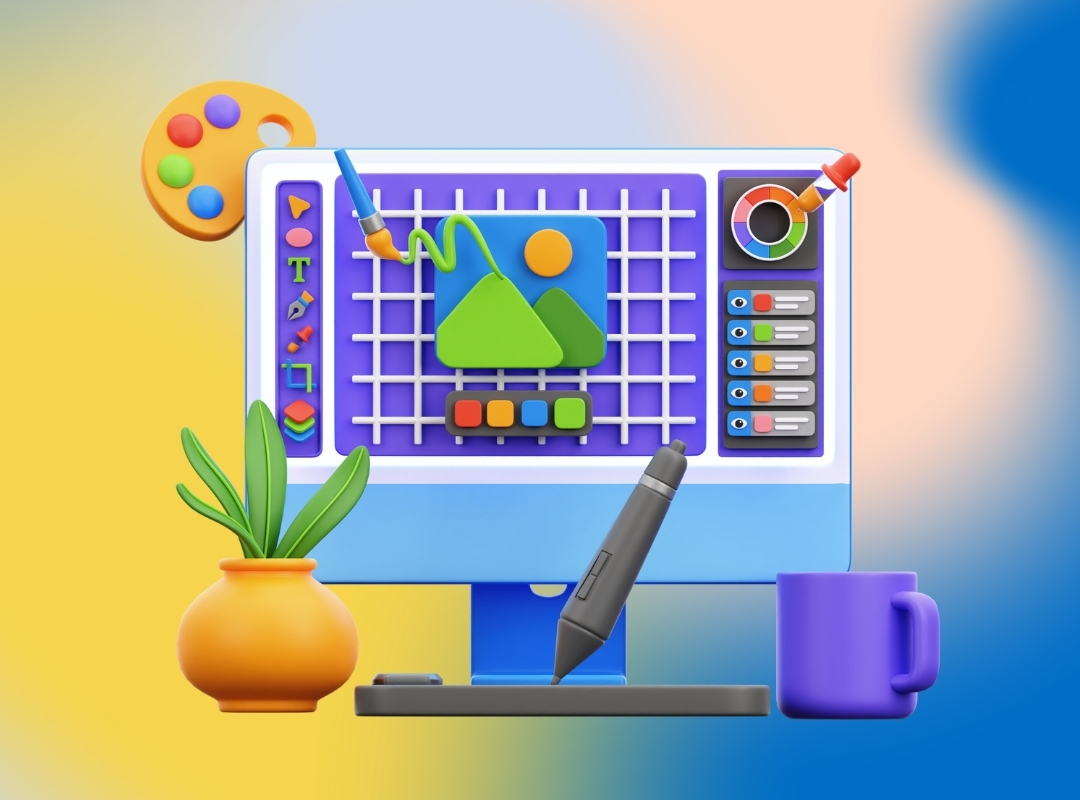You've created beautiful graphics and you're ready to get them out to the world. The only thing left to do (ok, not the only thing) is to translate your digital file into its final physical form.
Before deciding how to produce your artwork, consider the following questions:
- Is your project a short-run or a bulk order?
- What level of image quality and vibrancy do you want to achieve?
- Is your design highly detailed (contains more intricate artwork and colors), or on the simpler side?
- How durable do you need your final piece to be?
- Where will your graphic be displayed? For how long?
Two popular printing methods are screen printing and digital printing. Let’s explore each method in detail to help you decide which is best for your project.
What is Screen Printing?
Screen printing is a traditional print technique that has been used for many years before digital printing gained popularity. The screen printing process involves pushing several layers of ink through a customized stencil design onto the surface of the print material. This method is known for its vibrant color output and durability.
Screen printing is particularly advantageous for projects that require precise color matching, long-term durability, and vibrant colors. For instance, if you need a perfect PMS match or something particularly vibrant, screen printing is ideal. The ink in screen printing is thicker than in digital printing, which results in more vibrant colors and higher opacity. This method is also highly durable, making it the best choice for long-term use, as the thicker ink layers make the final print more resistant to wear and tear.
Additionally, screen printing can be done on a wider variety of materials, including textiles, ceramics, wood, and more, making it highly versatile. If your project requires special effects or finishes, such as metallic, glitter, or neon inks, screen printing offers a range of specialty inks that are not typically available with digital printing. Moreover, once the initial setup is complete, the cost per unit for large runs decreases significantly, making screen printing the economical choice for large quantities.
What is Digital Printing?
Digital printing, on the other hand, is a modern technique that involves creating a digital image that is then printed on the material via laser or inkjet technology. This method is excellent for detailed designs and smaller print runs.
Digital printing excels in producing highly detailed images with complex designs, making it perfect for projects that require high resolution and fine details. For example, retail signage that requires detailed and colorful in-store signs to capture customer attention, or custom displays that need unique elements for different stores or campaigns, can benefit from the high-resolution output and easy personalization that digital printing provides.
For projects that require smaller quantities, digital printing is more economical because the setup costs are much lower in comparison to screen printing. This makes it suitable for short-term promotions, such as temporary signage for events like flash sales or limited-time offers, and prototype displays when testing new retail display concepts. Furthermore, digital printing has a faster production time, making it more ideal for projects with tighter deadlines.
Choosing Between Screen Printing & Digital Printing
When deciding between screen printing and digital printing for your print projects, it’s essential to understand the strengths and limitations of each method.
Advantages of Digital Printing
- Customization and Precision: Digital printing excels in producing highly detailed images with complex designs. This method is perfect for projects that require high resolution and fine details, for example, retail signage and other custom displays. Digital printing allows easy personalization without extra costs, making it ideal for custom-designed window clings promoting seasonal sales or high-quality prototypes of new retail display concepts.
- Cost-Effectiveness for Short-Run Prints: For projects that require smaller quantities, digital printing is more economical because it doesn’t involve high setup costs. This makes it suitable for short-term promotions and temporary signage for events, trade shows, activations, conferences, etc.
Quick Turnaround Time: Digital printing has a faster setup and production time, making it ideal for projects with tight deadlines. When you need fast production for last-minute marketing campaigns or store openings, digital printing can deliver high-quality prints quickly.
Advantages of Screen Printing
- Durability and Longevity: Screen printing produces prints with thick layers of ink, making them highly durable and resistant to wear and tear. This is especially important for outdoor signage and signs in high-traffic areas, ensuring the graphics remain vibrant and intact over time.
- Vibrancy and Quality: The thicker ink used in screen printing results in more vibrant and saturated colors, making it suitable for branding displays and promotional posters. For displays that require precise color matching to brand guidelines, the ability to use Pantone colors ensures consistent and vibrant brand representation.
- Cost-Effectiveness for Bulk Orders: While the initial setup costs for screen printing are higher, the cost per unit decreases significantly for large quantities. This makes it ideal for large format graphics and bulk production of identical signs or displays.
Making the Decision
When deciding between screen printing and digital printing, consider the following factors:
- Quantity: Digital printing is cost-effective for small runs and quick jobs, while screen printing is more economical for large quantities.
- Detail and Design Complexity: Digital printing excels in producing intricate designs and gradients, whereas screen printing is better for bold, vibrant colors and precise color matching.
- Material and Usage: Screen printing is versatile across various materials and provides long-lasting prints suitable for outdoor and high-traffic areas. Digital printing works best on paper and paper-adjacent substrates and is ideal for indoor use.
- Budget and Time: Digital printing is suitable for projects with tight budgets and short timelines, while screen printing is better for long-term, large-scale projects with a higher initial investment.
Examples:
- Retail Window Displays: For a small batch of custom-designed window clings promoting a seasonal sale, digital printing would be ideal due to its detail and customization capabilities.
- Outdoor Banners: For a large order of durable outdoor banners advertising a year-long promotion, screen printing would provide the needed longevity and cost-effectiveness.
- Point-of-Purchase Displays: If you need a high volume of vibrant, attention-grabbing point-of-purchase displays for multiple store locations, screen printing offers the best quality and cost efficiency.
- Event Signage: For quick turnaround event signage with detailed graphics, digital printing allows for fast production and high-quality results.
By carefully evaluating your project’s specific needs, such as the quantity, design complexity, material, usage, budget, and timeline, you can choose the printing method that best meets your goals and ensures the highest quality outcome for your print project.
About BluEdge
BluEdge is a national provider of comprehensive Business Technology Solutions and Experiential Marketing Services. We’ve been supporting our clients since our establishment in 1898. BluEdge has been family-owned and operated for over 125 years and is proud to be a certified Woman Business Enterprise.
BluEdge has six locations in Carlstadt, NJ, New York, NY, Boston, MA, Philadelphia, PA, Washington, D.C., and Chicago, IL.
Need Something Printed?
Send us a message and one of our graphics experts will get back to you shortly.






